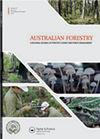Using topographic attributes to predict the density of vegetation layers in a wet eucalypt forest
IF 0.9
4区 农林科学
Q3 FORESTRY
引用次数: 1
Abstract
ABSTRACT Mapping the structure of forest vegetation with field surveys or high-resolution light detection and ranging (LiDAR) data is costly. We tested whether landscape topography and underlying geology could predict the vegetation density of a 19 km2 area of wet eucalypt forest at the Warra Long-Term Ecological Research Supersite, Tasmania, Australia. Using spatial layers for 12 topographic attributes derived from digital terrain models (DTMs) and a geology layer, we predicted the vegetation density of three strata with a high degree of accuracy (validation root mean square error ranged from 9.0% to 13.7%). The DTMs with 30 m resolution provided greater predictive accuracy than DTMs with higher resolution. The importance of different variables depended on spatial resolution and strata. Among the predictor variables, geology generally had the highest predictive importance, followed by solar radiation. Topographic Position Index, aspect, and System for Automated Geoscientific Analyses (SAGA) Wetness Index had moderate importance. This study demonstrates that geological and topographic attributes can provide useful predictions for the density of vegetation layers in a tall wet sclerophyll primary forest. Given the good performance of the model based on 30 m DTM resolution, the predictive power of the models could be tested on a larger geographical area using lower-density LiDAR point clouds combined with medium-resolution satellite data.利用地形属性预测湿桉树林中植被层密度
利用野外调查或高分辨率光探测和测距(LiDAR)数据绘制森林植被结构是昂贵的。在澳大利亚塔斯马尼亚州的Warra长期生态研究中心,我们测试了景观地形和地下地质是否可以预测19平方公里湿桉树森林的植被密度。利用基于数字地形模型(DTMs)的12个地形属性空间层和1个地质层,对3个地层的植被密度进行了高精度预测(验证均方根误差在9.0% ~ 13.7%之间)。分辨率为30 m的dtm比分辨率更高的dtm具有更高的预测精度。不同变量的重要性取决于空间分辨率和地层。在预测变量中,地质通常具有最高的预测重要性,其次是太阳辐射。地形位置指数、坡向和自动化地球科学分析系统(SAGA)湿度指数具有中等重要性。该研究表明,地质和地形属性可以为高湿硬叶原生林的植被层密度提供有用的预测。考虑到基于30 m DTM分辨率的模型的良好性能,可以使用低密度LiDAR点云结合中分辨率卫星数据在更大的地理区域上测试模型的预测能力。
本文章由计算机程序翻译,如有差异,请以英文原文为准。
求助全文
约1分钟内获得全文
求助全文
来源期刊

Australian Forestry
FORESTRY-
CiteScore
3.70
自引率
4.80%
发文量
15
审稿时长
>12 weeks
期刊介绍:
Australian Forestry is published by Taylor & Francis for the Institute of Foresters of Australia (IFA) for scientific, technical, and professional communication relating to forestry in the Asia Pacific.
 求助内容:
求助内容: 应助结果提醒方式:
应助结果提醒方式:


